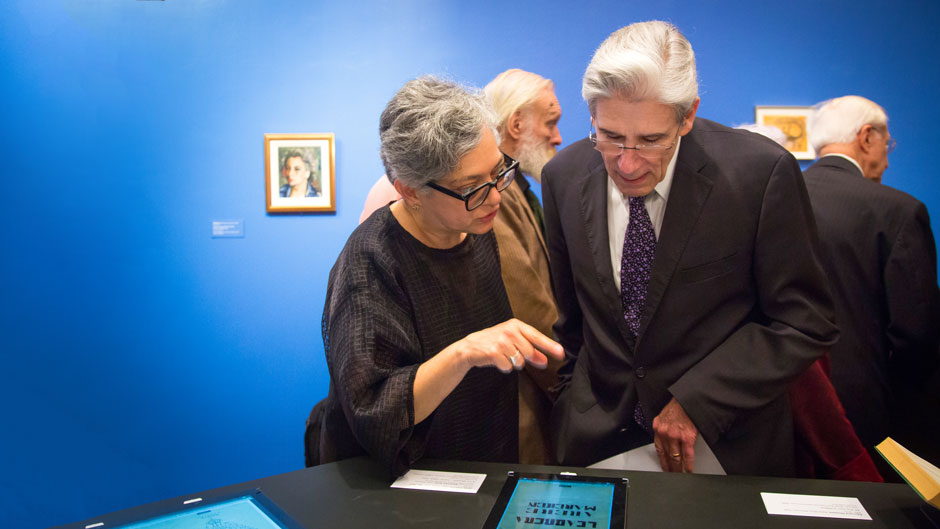To this day, the most comprehensive study of Afro-Cuban religions and customs in the world remains the oeuvre of Lydia Cabrera.
Writer, ethnographer, queer, white, upper middle class, independent thinker. All these adjectives describe Cuban-born Cabrera, who died in Miami in 1991, but not before leaving behind scores of books, documents, notebooks, religious artifacts, letters, and photographs that are permanently housed as the Lydia Cabrera Papers in the University of Miami Libraries Cuban Heritage Collection (CHC).
Many of those objects are now part of a new exhibit called Lydia Cabrera and Édouard Glissant: Trembling Thinking, which opened in early October at the Americas Society and Council of the Americas in New York City.
“Lydia Cabrera and Glissant are considered preeminent intellectuals in the Caribbean,” said Elizabeth Cerejido, director of the CHC and Esperanza Bravo de Varona Chair. “She was also an independent scholar who did not follow a traditional academic path. Glissant would be her counterpart. He is from Martinique and his approach to writing about Antillean or Caribbean cultural identity emphasized the effects of colonialism and race which underscored both history and politics, noting how they are shaped in ways that are both plural and global.”
The exhibit, which will run until Jan. 12, 2019, includes a generous display of Cabrera’s holdings, as well as digital facsimiles of her illustrated manuscript Arere mareken: cuento negro, eight first editions of Cabrera’s writings on Afro-Cuban culture, her earliest book published in 1936 as well as drawings and notebooks Cabrera used when conducting fieldwork with practitioners of Afro-Cuban religions in Havana, Matanzas, and Trinidad.
Cabrera spent a lifetime studying Afro-Cuban religions and folklore from a very intimate perspective. “She became embedded in the culture,” said Cerejido.
Her writings include El Monte, considered the seminal work on the Santería religion. Five works on paper by noted Afro-Chinese Cuban artist Wifredo Lam are also in the exhibit, including a portrait of Lydia Cabrera. These were bequeathed to UM by Cabrera and are on loan from UM’s Lowe Art Museum.
The exhibit brings together the work and world views of Cabrera and Glissant and also displays the art work of contemporary artists who are influenced by their intellectual sensibilities and notions of identity, said Cerejido.
The showing begins to fulfill one of Cerejido’s goals of expanding the reach of the CHC holdings beyond the confines of the library.
An opening panel with the curators and reception in New York was well attended, said Cerejido, who flew up for the occasion with her team that collaborated closely on the exhibition to make it a success.
A book titled "Lydia Cabrera: Between the Sum and the Parts" will be published in 2019 featuring an essay called “On Becoming the Archive: Lydia Cabrera and the Transnational Production of Afro-Cuban Knowledge” by Martin Tsang, the CHC’s Librarian and Curator of Latin American Collections.
“Collaborating on the exhibition has been tremendously exciting for us,” said Tsang. “The focus on Lydia Cabrera is a testament to the multiple ways that she has and continues to inflect our understanding of the formation of an intellectual creolized archipelago.
“Cabrera’s archive held at the CHC continues to inspire discourse and debates in such diverse yet deeply connected themes of race, art, colonialism, and identity and we are evermore understanding of Cabrera’s pivotal positionality and contributions to these fields,” he continued.
UM President Julio Frenk spent time viewing the exhibit and was escorted by Gabriela Rangel, chief curator and director of visual arts for the Americas Society. Maria de Lourdes Dieck-Assad, UM’s vice president for hemispheric and global affairs, also attended, as well as several long-time supporters of the CHC.
Rangel commented on Cabrera: “Cabrera was a self-taught polymath who should be paired to Glissant and who understood José Marti’s idea of the archipelago as a passage to the crossroads of the world.”

